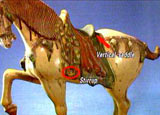 |
|
Charioteer’s Art and Horsemanship |
| CCTV.COM 2003-11-26 10:11:10 |
|
 Chinese ancestors commanded superb charioteer’s art and horsemanship during the Shang and Zhou dynasties over 3,000 years ago. With the development of science and technology, great changes have taken place in the forms of chariot racing and horse racing. But people are still eager to outdo themselves and dash forward at the maximum speed. Chinese ancestors commanded superb charioteer’s art and horsemanship during the Shang and Zhou dynasties over 3,000 years ago. With the development of science and technology, great changes have taken place in the forms of chariot racing and horse racing. But people are still eager to outdo themselves and dash forward at the maximum speed.
Chariots and horses played a very important role in social life in ancient times. From the number of chariots and horses one could estimate the military strength of a state. In those days, a chariot with four horses was known as a “sh岢ng”. One “sh岢ng” consisted of one chariot, four horses, three armored soldiers and 72 foot soldiers. “A state of a thousand chariots” or “a state of 10,000 chariots” was a term used to indicate the armed forces of a state in those days.
Since chariots and horses were so important, sons of aristocrats learned to drive chariots as an important part of their learning.
 “From the Shang Dynasty to the Western Zhou Dynasty, learning to drive chariots reached a high tide. It was part of school learning. Six classical arts were taught at schools. They were rites, music, archery, riding, writing and arithmetic. Riding referred to the art of driving chariots. There were five basic skills of driving chariots. Two different kinds of bells were attached to each chariot. They sounded in harmony, showing the charioteer’s good skill. “From the Shang Dynasty to the Western Zhou Dynasty, learning to drive chariots reached a high tide. It was part of school learning. Six classical arts were taught at schools. They were rites, music, archery, riding, writing and arithmetic. Riding referred to the art of driving chariots. There were five basic skills of driving chariots. Two different kinds of bells were attached to each chariot. They sounded in harmony, showing the charioteer’s good skill.
The driver had to drive the chariot stably across the complex terrain. He had to follow the etiquette when he drove pass the monarch. He had to drive safely through crossroads with crowds of people. He had to drive the enemies and animals ahead to the left of the chariot. So the archer on the chariot could be in the best position to shoot,” said Cui Lequan, research fellow of China Sports Museum.
Before the Warring States Period, chariots and horses were closely related to each other. Generally speaking, there was not a chariot without horses or a horse not attached to a chariot. Driving a horse meant driving a chariot. The situation changed during the Warring States Period over 2,000 years ago. More and more people rode on horseback. Horsemanship was divorced from the charioteer’s art.
 From the Han Dynasty to the Wei and Jin dynasties, Chinese craftsmen improved the horse gear to serve military purposes. They invented the vertical saddle and stirrup. In particular, the invention of the stirrup was a contribution to the world. The stirrup made it very convenient to ride on horseback. The technical progress propelled the improvement of horsemanship in ancient China. From the Han Dynasty to the Wei and Jin dynasties, Chinese craftsmen improved the horse gear to serve military purposes. They invented the vertical saddle and stirrup. In particular, the invention of the stirrup was a contribution to the world. The stirrup made it very convenient to ride on horseback. The technical progress propelled the improvement of horsemanship in ancient China.
The horsemanship in ancient China was divided into the horse racing and the circus. According to historical data, horse racing was very popular during the Han Dynasty. Circuses began to give performances in towns. They were one of the major forms of variety show in those days. Horsemanship was the main form of training for cavalrymen during the Ming and Qing dynasties. Today the tradition of horsemanship can still be seen in many areas inhabited by ethnic minorities in China.
|
|
Editor: Han Ling CCTV.com
|
|
|
|
|
|
 |









